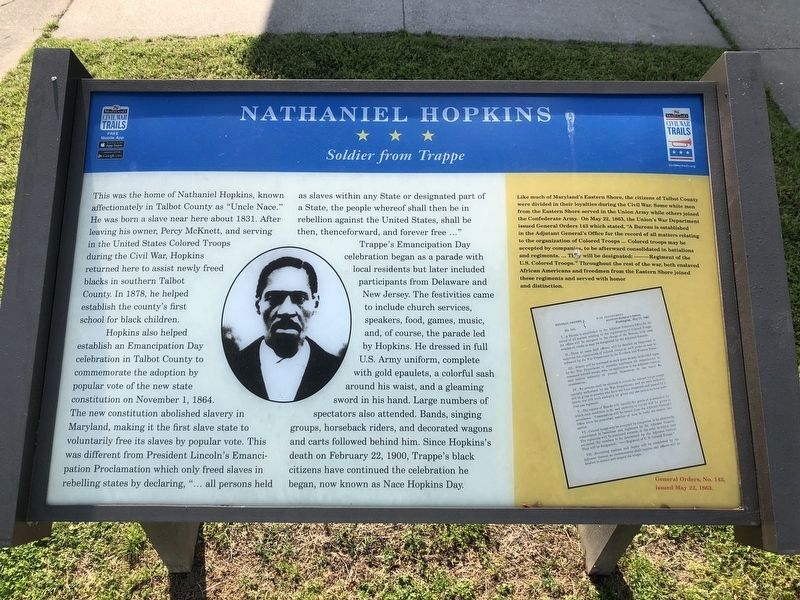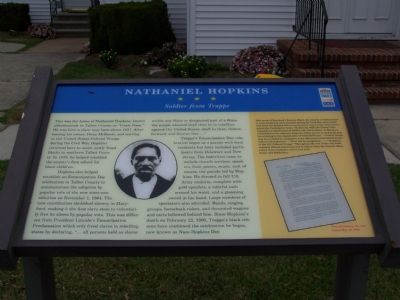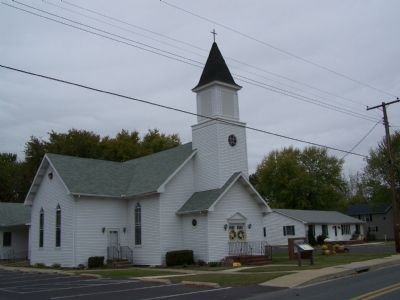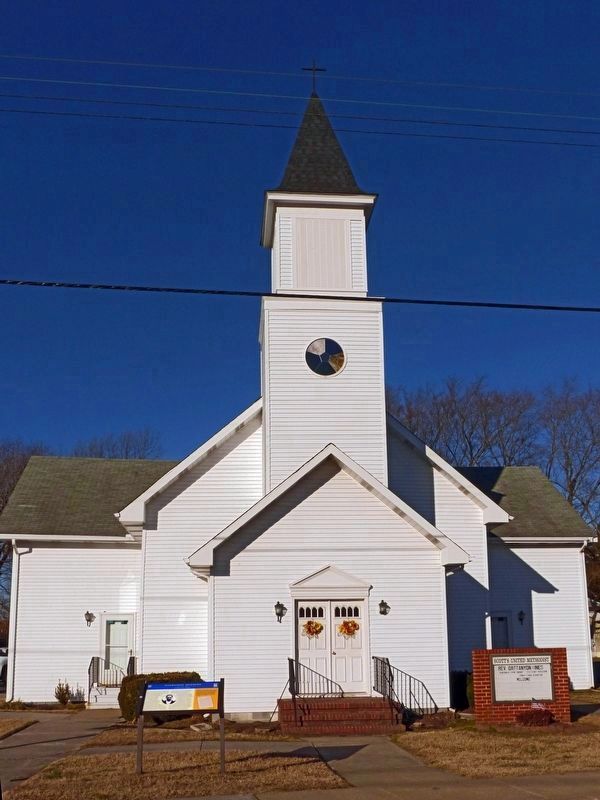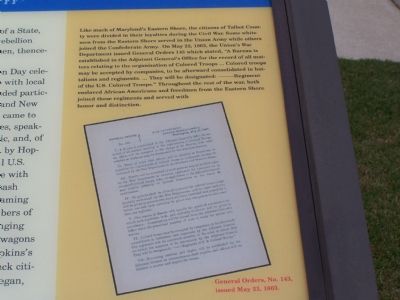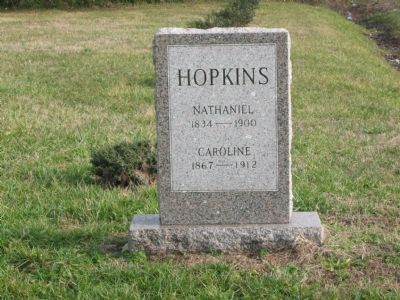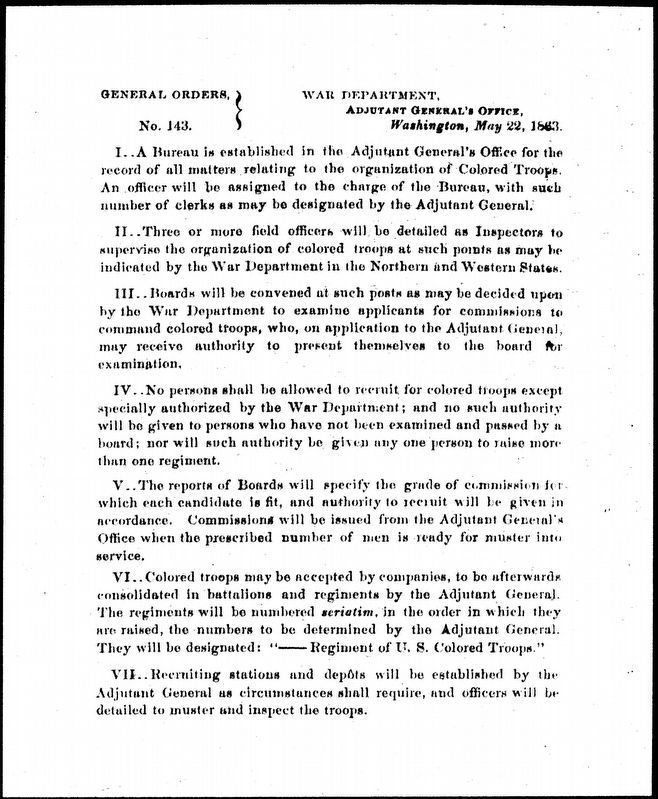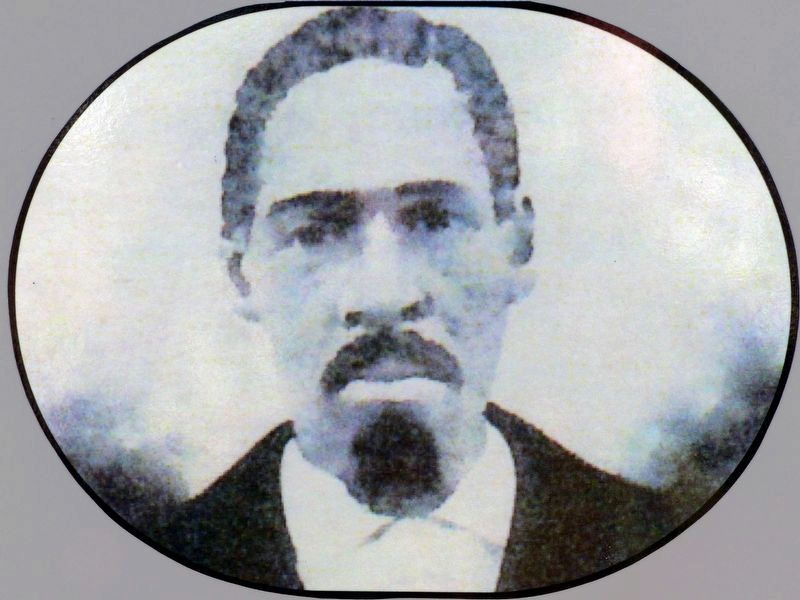Trappe in Talbot County, Maryland — The American Northeast (Mid-Atlantic)
Nathaniel Hopkins
Soldier from Trappe
Hopkins also helped establish an Emancipation Day celebration in Talbot County to commemorate the adoption by popular vote of the new state constitution on November 1, 1864. The new constitution abolished slavery in Maryland, making it the first slave state to voluntarily free its slaves by popular vote. This was different from President Lincoln's Emancipation Proclamation which only freed slaves in rebelling states by declaring "... all persons held as slaves within any State or designated part of a State the people whereof shall then be in rebellion against the United States, shall be then, thence forward, and forever free..."
Trappe's Emancipation Day celebration began as a parade with local residents but later included participants from Delaware and New Jersey. The festivities came to include church services, speakers, food, games, music, and, of course, the parade led by Hopkins. He dressed in full U. S. Army uniform, complete with gold epaulets, a colorful sash around his waist, and a gleaming sword in his hand. Large numbers of spectators also attended. Bands, singing groups, horseback riders, and decorated wagons and carts followed behind him. Since Hopkins's death on February 22, 1900, Trappe's black citizens have continued the celebration he began now known as Nace Hopkins Day.
(Sidebar, on right): Like much of Maryland's Eastern Shore, the citizens of Talbot County were divided in their loyalties during the Civil War. Some white men from the Eastern Shore served in the Union Army while others joined the Confederate Army. On May 22, 1863, the Union's War Department issued General Orders 143 which stated, "A Bureau is established in the Adjutant General's Office for the record of all matters relating to the organization of Colored Troops...Colored troops may be accepted by companies, to be afterward consolidated in battalions and regiments. ... They will be designated: --------- Regiment of the U. S. Colored Troops." Throughout the rest of the war, both enslaved African Americans and freedmen from the Eastern Shore joined these regiments and served with honor and distinction.
General Orders, No. 143.
War Department, Adjutant General's Office, Washington, May 22, 1863.
I..A Bureau is established in the Adjutant General's Office for the record of
all matters relating to the organization of Colored Troops. An officer will be assigned to the charge of the Bureau, with such number of clerks as may be designated by the Adjutant General.
II..Three or more field officers will be detailed as Inspectors to supervise the organization of colored troops at such points as may be indicated by the War Department in the Northern and Western States.
III..Boards will be convened at such posts as may be decided upon by the War Department to examine applicants for commissions to command colored troops, who, on application to the Adjutant General, may receive authority to present themselves to the board for examination.
IV..No persons shall be allowed to recruit for colored troops except specially authorized by the War Department; and no such authority will be given to persons who have not been examined and passed by a board; nor will such authority be given any one person to raise more than one regiment.
V..The reports of Boards will specify the grade of commission for which each candidate is fit, and authority to recruit will be given in accordance. Commissions will be issued from the Adjutant General's Office when the prescribed number of men is ready for muster into service.
VI..Colored troops may be accepted by companies, to be afterward consolidated in battalions and regiments by
the Adjutant General. The regiments will be numbered seriatim, in the order in which they are raised, the numbers to be determined by the Adjutant General. They will be designated: "--------- Regiment of U. S. Colored Troops."
VII..Recruiting stations and depots will be established by the Adjutant General as circumstances shall require, and officers will be detailed to muster and inspect the troops.
General Orders, No. 143,
issued May 22, 1863.
Erected by Maryland Civil War Trails.
Topics and series. This historical marker is listed in these topic lists: Abolition & Underground RR • African Americans • Education • War, US Civil. In addition, it is included in the Former U.S. Presidents: #16 Abraham Lincoln, and the Maryland Civil War Trails series lists. A significant historical year for this entry is 1831.
Location. 38° 39.136′ N, 76° 3.438′ W. Marker is in Trappe, Maryland, in Talbot County. Marker is at the intersection of Main Street (Maryland Route 565) and Barber Road, on the right when traveling south on Main Street. Touch for map. Marker is in this post office area: Trappe MD 21673, United States of America. Touch for directions.
Other nearby markers. At least 8 other markers are within 4 miles of this marker, measured as the crow flies. Nathaniel (Nace) Hopkins (within shouting distance of this marker); “Compton” (within shouting
distance of this marker); Site of Trappe High School (approx. 0.3 miles away); Home Run Baker Park (approx. 0.9 miles away); “Hole-in-the-Wall” (approx. 3 miles away); Old White Marsh Episcopal Church (approx. 3.1 miles away); Robert Morris, Sr. (approx. 3.1 miles away); “The Wilderness” (approx. 4 miles away). Touch for a list and map of all markers in Trappe.
Additional commentary.
1. Emancipation Celebration - How the Eastern Shore Honors "Uncle Nace"
Since 1867, the small town of Trappe (population 1,146), located in Talbot County, midway between Easton and Cambridge, has hosted the longest continuously running celebration on the Eastern Shore. The event was originated by Nathanial Hopkins (affectionately known as “Uncle Nace”), a former slave, Civil War veteran, and civic and religious leader.
Uncle Nace’s Day is a unique commemoration of Maryland Emancipation Day, November 1, 1864, when Maryland adopted a new state constitution that abolished slavery and made it the first slave state to voluntarily free its slaves by popular vote
(Lincoln’s Emancipation Proclamation of 1863 had only freed slaves in states of rebellion, of which Maryland was not one).
For 139 years, the Hopkins family and the Trappe community have kept the observance alive. In Trappe: The Story of an Old Fashioned Town, Dickson Preston writes that “in Trappe, alone of all places on the southern-oriented Eastern Shore, the Negro community was given the freedom of the town each year to celebrate the end of slavery. That didn’t happen anywhere else in Maryland. It didn’t happen many places in all of America. The fact that it did happen in Trappe…is something of which blacks and whites alike can be proud.”
For many years, the celebration continued to be held on November 1st (since amended to a Saturday in October). It was a holiday when schools closed and people spent the day in celebration and reflection. For the first 30 years, Uncle Nace himself led the parade, resplendent in full U.S. Army uniform—complete with gold epaulets, a silk sash around his waist, and gleaming sword (the same one still carried by his descendents in the parade today)—followed by bands, singing groups, horseback riders, children, and decorated wagons and carts.
Large numbers of spectators attended, and there were horse races, games, feasting, and dances in the evening. At a grandstand erected near the church,
orators from as far away as Baltimore delivered speeches, often with a political bent because of the event’s proximity to Election Day. Regardless of any political undertones, though, the celebration is generally recalled as a semi-religious time, where those who had known slavery expressed gratitude for freedom.
Nace Hopkins, a large man with strong features and piercing eyes, was far more than just a colorful local character who liked to dress up and lead parades, however. Hopkins was known and respected as being industrious, a good churchman, and an advocate for children and the book-learning he had been denied under slavery. (The recently-established Nace Hopkins Scholarship Fund carries on this advocacy by helping local youth seek higher education.)
In October 1871, Hopkins was one of a group of black residents who met to incorporate their former “African church,” which eventually became Scotts United Methodist Church. He was also instrumental in building Trappe’s first so-called “colored schoolhouse” on a site near the church. Children revered his name, and letters still prized by his descendants testify to the respect both whites and blacks had for him.
Nace Hopkins died February 22, 1900, and was buried in the Old Paradise Cemetery at what is now the corner of U.S. Route 50 and Barber Road. After his death, others carried
on for him, but the celebration continued to be called “Uncle Nace’s Day.”
Despite lack of funds, waning interest, and racial tensions that have threatened its demise, the celebration has withstood the test of time. In 1976, when the town of Trappe planned its bicentennial celebration, one of the chosen goals of the event committee was to help raise funds to revitalize Nace’s Day.
“We thought it was important to recognize and revive the celebration,” says Hilda Jane Groves, who chaired the committee. “The community was really behind it: The town commissioners, fire department, school, and citizens wanted to keep it alive.”
Funds raised by the committee helped purchase a new headstone for Nathaniel Hopkins’ gravesite. Today, Hopkins’ great-great-grandson Dale Brown leads a visit to the grave as part of the Nace’s Day celebration. Brown is president of the Eastern Shore Buffalo Soldiers Motorcycle Club, one of the centerpieces of the modern parades. The club takes its name from black members of the U.S. Army—the Buffalo Soldiers—who helped blaze the treacherous trails of the Westward Movement.
From a Maryland Life Magazine article published in 2006.
— Submitted November 5, 2007, by Kevin W. of Stafford, Virginia.
Credits. This page was last revised on August 10, 2020. It was originally submitted on November 5, 2007, by Bill Pfingsten of Bel Air, Maryland. This page has been viewed 3,947 times since then and 45 times this year. Last updated on August 9, 2020, by Carl Gordon Moore Jr. of North East, Maryland. Photos: 1. submitted on May 17, 2020, by Devry Becker Jones of Washington, District of Columbia. 2, 3. submitted on November 5, 2007, by Bill Pfingsten of Bel Air, Maryland. 4. submitted on January 21, 2018, by Allen C. Browne of Silver Spring, Maryland. 5. submitted on November 5, 2007, by Bill Pfingsten of Bel Air, Maryland. 6. submitted on November 30, 2007, by F. Robby of Baltimore, Maryland. 7, 8. submitted on January 21, 2018, by Allen C. Browne of Silver Spring, Maryland.
Editor’s want-list for this marker. Pictures of Uncle Nace's Day celebration. • Can you help?
